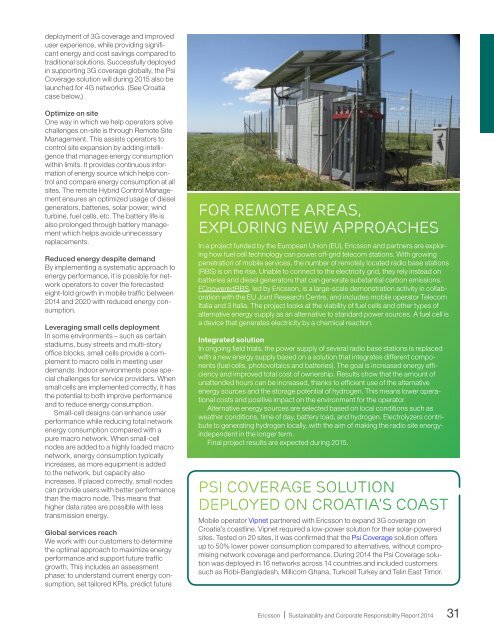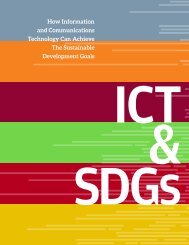Ou7h5
Ou7h5
Ou7h5
You also want an ePaper? Increase the reach of your titles
YUMPU automatically turns print PDFs into web optimized ePapers that Google loves.
deployment of 3G coverage and improveduser experience, while providing significantenergy and cost savings compared totraditional solutions. Successfully deployedin supporting 3G coverage globally, the PsiCoverage solution will during 2015 also belaunched for 4G networks. (See Croatiacase below.)Optimize on siteOne way in which we help operators solvechallenges on-site is through Remote SiteManagement. This assists operators tocontrol site expansion by adding intelligencethat manages energy consumptionwithin limits. It provides continuous informationof energy source which helps controland compare energy consumption at allsites. The remote Hybrid Control Managementensures an optimized usage of dieselgenerators, batteries, solar power, windturbine, fuel cells, etc. The battery life isalso prolonged through battery managementwhich helps avoide unnecessaryreplacements.Reduced energy despite demandBy implementing a systematic approach toenergy performance, it is possible for networkoperators to cover the forecastedeight-fold growth in mobile traffic between2014 and 2020 with reduced energy consumption.Leveraging small cells deploymentIn some environments – such as certainstadiums, busy streets and multi-storyoffice blocks, small cells provide a complementto macro cells in meeting userdemands. Indoor environments pose specialchallenges for service providers. Whensmall cells are implemented correctly, it hasthe potential to both improve performanceand to reduce energy consumption.Small-cell designs can enhance userperformance while reducing total networkenergy consumption compared with apure macro network. When small-cellnodes are added to a highly loaded macronetwork, energy consumption typicallyincreases, as more equipment is addedto the network, but capacity alsoincreases. If placed correctly, small nodescan provide users with better performancethan the macro node. This means thathigher data rates are possible with lesstrans mission energy.Global services reachWe work with our customers to determinethe optimal approach to maximize energyperformance and support future trafficgrowth. This includes an assessmentphase: to understand current energy consumption,set tailored KPIs, predict futurefor remote areas,exploring new approachesIn a project funded by the European Union (EU), Ericsson and partners are exploringhow fuel cell tech nology can power off-grid telecom stations. With growingpenetration of mobile services, the number of remotely located radio base stations(RBS) is on the rise. Unable to connect to the electricity grid, they rely instead onbatteries and diesel generators that can generate substantial carbon emissions.FCpoweredRBS, led by Ericsson, is a large-scale demonstration activity in collaborationwith the EU Joint Research Centre, and includes mobile operator TelecomItalia and 3 Italia. The project looks at the viability of fuel cells and other types ofalternative energy supply as an alternative to standard power sources. A fuel cell isa device that generates electricity by a chemical reaction.Integrated solutionIn ongoing field trials, the power supply of several radio base stations is replacedwith a new energy supply based on a solution that integrates different components(fuel cells, photovoltaics and batteries). The goal is increased energy efficiencyand improved total cost of ownership. Results show that the amount ofunattended hours can be increased, thanks to efficient use of the alternativeenergy sources and the storage potential of hydrogen. This means lower operationalcosts and positive impact on the environment for the operator.Alternative energy sources are selected based on local conditions such asweather conditions, time of day, battery load, and hydrogen. Electrolyzers contributeto generating hydrogen locally, with the aim of making the radio site energyindependentin the longer term.Final project results are expected during 2015.Psi coverage solutiondeployed on Croatia’s coastMobile operator Vipnet partnered with Ericsson to expand 3G coverage onCroatia’s coastline. Vipnet required a low-power solution for their solar-poweredsites. Tested on 20 sites, it was confirmed that the Psi Coverage solution offersup to 50% lower power consumption compared to alternatives, without compromisingnetwork coverage and performance. During 2014 the Psi Coverage solutionwas deployed in 16 networks across 14 countries and included customerssuch as Robi-Bangladesh, Millicom Ghana, Turkcell Turkey and Telin East Timor.Ericsson | Sustainability and Corporate Responsibility Report 201431







